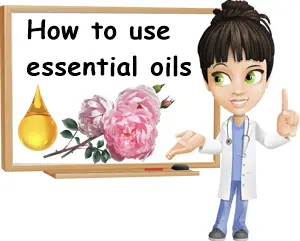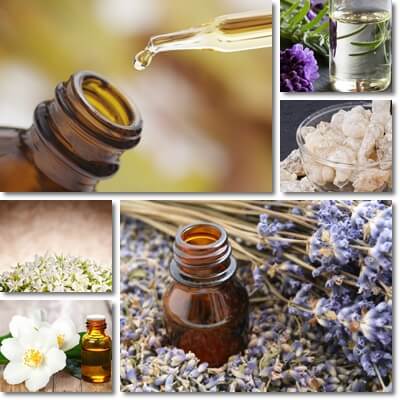Essential oils are pleasantly scented oils obtained from the most fragrant parts of a plant, most notably flowers, leaves, peel and seeds, but also fruits, twigs, wood, bark, root and resin. Versus carrier oils which are typically edible, essential oils are inedible, toxic even if ingested, no matter how small the amounts, or used topically above the recommended dosage.
Main uses for essential oils include perfumery and aromatherapy, but some may be used as food additives and even green pesticides. Topical use requires dilution with edible carrier oils, but even so, poses certain risks such as contact dermatitis, photosensitivity, allergic reactions or liver toxicity, among other side effects.
What are essential oils?
Essential oils are volatile and aromatic organic compounds from plants. Essential oils are not actually oils, but liquid fragrance extracted from various plants. The name ‘essential oil’ comes from the aroma or essence of a plant being extracted in a liquid form that provides the feel of an oil, despite not actually being one. The oil feel that contributes to their name is owed to the fact that the volatile organic compounds that make up essential oils are hydrophobic (which means they don’t dissolve in water, similar to actual oils) and lipophilic (which means they have an affinity for combining with lipids or fats, hence the reason they can be diluted with carrier oils).

What are essential oils made of?
Essential oils are made of volatile and aromatic organic compounds. Volatile means they evaporate in the air at normal room temperature and pressure. Aromatic means they have a fragrance, a perfume or odor, specific to the plant they are extracted from. Organic means they are extracted from living organisms, plants, so not synthetic.
Basically, essential oils are extracted plant fragrance. The fragrance is most commonly extracted through (steam) distillation, but also solvent extraction or, more rarely, cold extraction followed by mechanical separation of the volatile and aromatic organic compounds which make up the essential oil.
Types of essential oils based on raw material
According to the different parts of a plant that lend themselves to fragrance extraction, the following types of essential oil exist:
- Essential oils made from plant flowers, blossoms or petals: rose, chamomile, lavender, rosemary, jasmine, ylang-ylang, yarrow, neroli (an essential oil made from bitter orange blossoms), scented geranium oil (or pelargonium essential oil) etc.
- Essential oils made from leaves: basil, bay leaf, curry leaf, sage leaf (also called true sage oil), eucalyptus, lemongrass, oregano, peppermint, spearmint, parsley, tea tree oil or melaleuca oil, thyme, perilla leaf oil (not the same thing as perilla seed oil).
- Essential oils made from peels or rind: primarily citrus oils such as grapefruit, lemon, lime, calamodin (the calamodin orange, calamansi or golden lime), bergamot orange, mandarin orange, tangerine, sweet orange and bitter orange essential oils.
- Essential oils made from bark: cinnamon or Cassia essential oil and sassafras root bark oil.
- Essential oils made from wood: camphor, sandalwood, rosewood, cedar wood and agarwood (agar or aloeswood) essential oil.
- Essential oils made from roots and rhizomes: sassafras root bark, angelica root (Angelica archangelica or garden angelica), valerian, cypress root and orris oil (made from iris roots/rhizomes).
- Essential oils made from seeds: anise, star anise, caraway, cardamon, cumin, celery, nutmeg, dill (can be made from either just dill seeds, or the whole plant), cubeb or tailed pepper, guava seed and carrot seed essential oil (not the same thing as pressed carrot seed oil).
- Essential oils made from fruits: anise or aniseed essential oil (made from the seeds that are botanically fruits), caraway essential oil (the seeds are actually fruits), juniper berries and allspice fruit essential oil.
- Essential oil made from resin: frankincense, myrrh, labdanum.

- Essential oils made from multiple plant parts:
- Example 1: sage oil can be made exclusively from sage leaves (true sage oil, made from Salvia officinalis, Salvia triloba, Salvia judaica and other species), flowering tops and leaves (clary sage oil, made from Salvia sclarea, or clary sage), leaves and twigs (Spanish sage oil, made from Salvia lavandulifolia).
- Example 2: pine oil (made from pine needles, twigs, even cones and bark or wood).
- Example 3: petitgrain oil (made from bitter orange leaves and young, green twigs and even branches; in the past, immature, underdeveloped, green oranges were used as well).
- Example 4: dill oil (made from either just dill seeds, or the whole dill plant, including the seeds, leaves and twigs).
- Example 5: angelica essential oil (made from either angelica root or angelica seeds).
- Example 6: dill oil (may be essential dill seed oil, or dill oil made from dill leaves or the whole plant – seeds, leaves, twigs or stems).
How do essential oils work?
Essential oils work via their biologically active compounds, that is, the volatile and aromatic compounds that provide them with their specific fragrance. The scent alone can induce relaxation of the nervous system, reduce stress, lower anxiety levels, boost mood, induce and potentially also improve sleep and bolster creativity and increase productivity. When used in perfumery, essential oils help boost self-esteem and confidence, contributing to an improved self-image and self-perceived attractiveness which can have a positive effect on disposition and interpersonal relationships.
Various compounds have diverse therapeutic properties and subsequent health benefits. For example, anethole, a compound in anise, star anise and basil and their essential oils, has antibacterial and antifungal and anti-yeast properties. In vitro studies show that anethole has anti-parasitic (antihelmintic) and anti-nematode activity. Thymol from thyme and thyme essential oil has antiseptic and analgesic properties. Camphor in camphor oil has analgesic and anesthetic properties. Eucalyptol from eucalyptus leaf essential oil has a cooling effect and mild cough-suppressing properties. Menthol from peppermint and spearmint essential oil has analgesic and anesthetic effects, antibacterial activity, decongestant action and a cooling effect that helps mask irritation and associated discomfort and pain.
Uses for essential oils
- Use in perfumes. Essential oils are most frequently known as perfume oils because of their extensive use in perfumery. Rose, sandalwood, cedar wood, basil, bergamot orange, citron, patchouli and geranium oil are all common ingredients in perfumes.
- Aromatherapy. Aromatherapy is a branch of alternative medicine that seeks to provide relief from pain, reduce or treat nausea, stress, anxiety, depression and other physical and physiological symptoms and even treat various psychological and physical ailments. While its effectiveness is heavily disputed, some users report effects such as improved mood, reduced stress, better sleep, lower anxiety levels and other benefits related primarily to mental health.
- Food flavoring. Despite being inedible and toxic if ingested or used undiluted, essential oils are being used to flavor food. For example, allspice, anise, caraway, peppermint and citrus essential oils in general (lemon, lime, citron, sweet orange etc.) are common food additives. In the amounts used to flavor food, essential oils are safe deemed safe.
- Use in cosmetics. Rose and other essential oils are commonly used in cosmetics to increase the appeal of the cosmetic product by giving it a scent that can be associated with cleanliness, naturalness and health.
- Use in cleaning and other household products. Various essential oils are added to household products such as cleaning agents to both improve their odor, increasing their appeal to consumers, and because of their natural antibacterial, antifungal and even insect-repellent properties.
- Religious uses. Myrrh and frankincense, but also other essential oils have been used in religious rituals since their discovery. Myrrh and frankincense play a big role in the history of Christianity, with frankincense being extensively used even today in Christian religious rituals. Myrrh is believed to have been used in ancient Egyptian embalming practices.
- Green pesticides. Many essential oils represent an effective alternative to commercial pesticides and insecticides due to their natural insect-repellent properties. Rose essential oil, lemongrass, lavender, eucalyptus, citronella and many more have proven insect and other pests-deterrent effects.
- Mosquito-repellents. Many essential oils are excellent mosquito repellents, although it’s important to remember that their continual use on the skin comes with a series of side effects, both short and long-term (even when used diluted as advised). I myself have tested this claim by rubbing on my arms lovage leaves and stems, lavender flowers, thyme, oregano and other herbs from my garden. The results were unexpected: a strong mosquito-repellent effect that lasted around 3-4 hours.
Benefits, side effects and risks
Versus carrier oils such as edible vegetable oils which are made of fatty acids (that is, fat), essential oils are made of aromatic and volatile compounds (that is, essence or fragrance compounds). Carrier oils contain fatty acids and fat-soluble vitamins (A, D, E, K), and thus provide nutritional benefits as well as moisturizing and emollient properties. Whereas essential oils contain elements with natural antibacterial, antifungal, even antiviral properties, but also anti-inflammatory and antioxidant activity. The pleasant odor of the volatile aromatic compounds further provides benefits for the nervous system, often promoting relaxation and reducing anxiety and stress and improving sleep, hence the use of essential oils in aromatherapy.
However, while carrier oils are typically edible and non-toxic, essential oils are neither edible, nor safe to use as they are (though safe in the amounts used to flavor food products). Essential oils have the potential to cause allergic reactions which can build up to anaphylactic shock. Undiluted essential oils have insect-repellent properties and deter pests in general which means they are toxic. In addition to insects, they are toxic for people of all ages, pets and other animals.
Topical use of undiluted essential oils can cause side effects such as severe irritation, skin photosensitivity (which, over time, increases the risk for melanoma skin cancers), hepatotoxicity, kidney and brain toxicity and more. Accidental or intentional ingestion of even the smallest amounts of essential oil can prove fatal – symptoms may include nausea, vomiting, diarrhea, confusion, drowsiness, muscle weakness and instability, rapid heartbeat, convulsions and, in severe cases, death. Some essential oils are potential carcinogens, causing cell damage that could promote cancer development. The risks are directly proportional with dosage, oil purity and length of use, with children being the most easily and severely affected.
Essential oils have side effects for pregnant women as well. Topical use or use in aromatherapy can cause nausea, vomiting and even headaches in pregnant women. Topical use or ingestion poses risks for the baby as well, including toxicity and miscarriage. Of course, not all essential oils carry risks this serious, and side effects are usually dose-dependent, with risks increasing with undiluted or insufficiently diluted oil, improper use and length of use.
